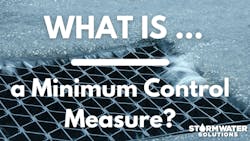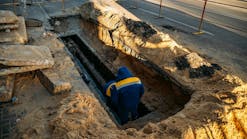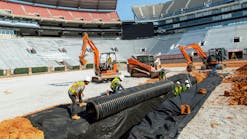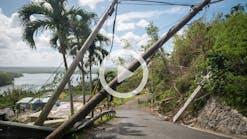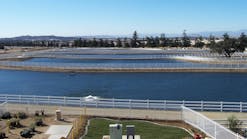What is a minimum control measure?
What is a minimum control measure?
Minimum control measures (MCMs) are measures implemented in managing municipal separate storm sewer systems (MS4s) under the U.S. Environmental Protection Agency’s (EPA) National Pollutant Discharge Elimination System (NPDES) program. The NPDES, part of the Clean Water Act, was enacted in 1972 with the aim to reduce pollutants discharged into receiving water bodies. Pollutants include sediment, nutrients, bacteria, pathogens and toxic chemicals, which can harm humans, aquatic life and ecosystems. This is especially important in urban areas as cities become denser and impervious areas increase, leading to faster-flowing, more concentrated runoff.
EPA MCMs
There are six MCMs outlined by the EPA. Each has associated best management practices (BMPs), tailored to the goals of the MCM, to minimize pollutants in stormwater runoff and discharge. The six MCMs provide the MS4s guidance in planning and implementing programs to manage stormwater within their service areas.
MCM 1 is Public Education. This MCM allows the MS4 to raise public awareness of how everyday activities affect stormwater quality and encourage residents to take steps to protect local waterways. For example, washing your car, littering, applying chemicals to your grass and proper disposal of pet waste all affect the quality of stormwater runoff. Examples of BMPs under this MCM include posting digestible information to social media accounts and distributing educational materials about stormwater pollution or partnering with local schools to incorporate stormwater education into the curriculum.
MCM 2 is Public Involvement. This MCM encourages MS4s to foster opportunities for the public to be involved in the efforts to minimize pollutants. This MCM promotes action from the community. Examples of BMPs for this MCM include providing stormwater education kits to local schools for hands-on learning and coordinating community volunteer events that restore area waterways.
MCM 3 is Illicit Discharge Detection and Elimination. MCM 3 requires the MS4 to devise and employ strategies to detect and address illicit discharges in the system. The EPA defines illicit discharges as “any discharge into a separate storm sewer system that is not composed entirely of stormwater.” Illicit discharges can contribute toxic pollutants, pathogens, bacteria and even high concentrations of nutrients. BMPs that an MS4 can implement to fulfill the requirements of this MCM are developing a storm sewer system map, training staff to undergo training to detect illicit discharges, and providing the public with means to report an illicit discharge.
MCM 4 is Construction Site Stormwater Runoff Control. Oftentimes, construction sites are disruptive of the existing soil and involve using chemicals and materials to develop the site, which can result in large amounts of sediment and waste introduced into the storm sewer system and downstream water bodies. Therefore, the MS4 develops and implements policies and procedures to reduce the amount of stormwater runoff from construction sites. Examples of such policies include reviewing and approving proposed construction plans for comprehensive storm water pollution prevention plans, providing all contractors with an informational packet regarding all rules and regulations they need to follow on their construction site, and implementing procedures to inspect active construction sites.
MCM 5 is Post-Construction Stormwater Management in New Development and Redevelopment. This MCM directly follows the intent behind MCM 4. Where MCM 4 requires the development of policies to control runoff in construction sites, MCM 5 requires the development of policies after construction is complete. Developments can cause an increase in runoff as vegetation is replaced by impermeable surfaces. As a result, best management practices under MCM 4 include post-construction, final inspections of every construction site, continuous inspections after site establishment to ensure adequate operations of all structural and non-structural controls, and policies in place to address any issues associated with post-construction runoff.
MCM 6 is Pollution Prevention and Good Housekeeping for Municipal Operations. While the other MCMs directly regulate the public or contractors, this MCM focuses on the MS4’s accountability. MS4 maintenance activities and facilities can also be sources of stormwater pollutants. The MS4s manage their systems to ensure their operations do not contribute to system waste. Examples of how the MS4 can implement BMPs are training staff in good housekeeping, maintaining an inventory and inspecting the condition of all facilities and stormwater controls, and evaluating and keeping records of waste disposal.
Under the Clean Water Act and NPDES, the EPA outlines these MCMs as measures to decrease the overall pollutants that enter the nation’s storm sewer systems and bodies of water. By integrating these MCMs into planning and stormwater management practices, MS4s can foster healthier, more livable communities while protecting the water resources that we all depend on.
Adrian Bustios | EIT
Adrian Bustios, EIT is with Lockwood, Andrews and Newnam, Inc. (LAN-inc.com) on the Water District Engineering team in Houston, Texas. Bustios can be reached at [email protected].
Abby Stanhouse
Abby Stanhouse, PE, is with Lockwood, Andrews and Newnam, Inc. (LAN-inc.com) on the Water District Engineering team in Houston, Texas. Stanhouse is also a project manager for the CLCWA’s Exploration Green Detention Facility project.
